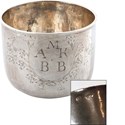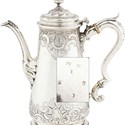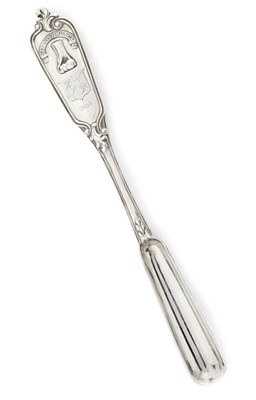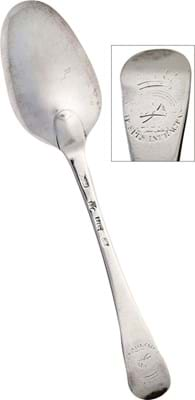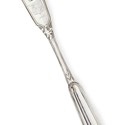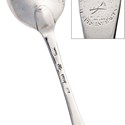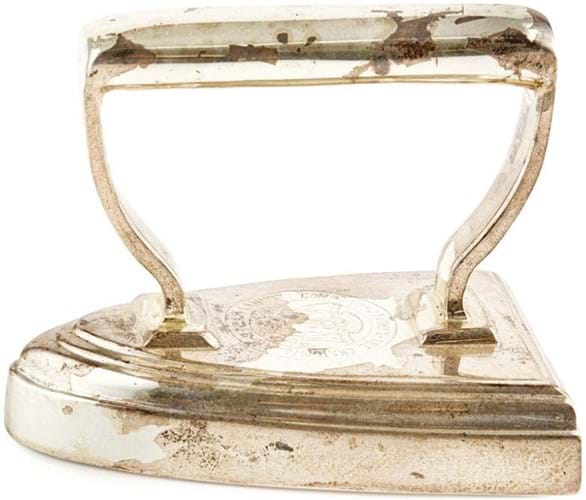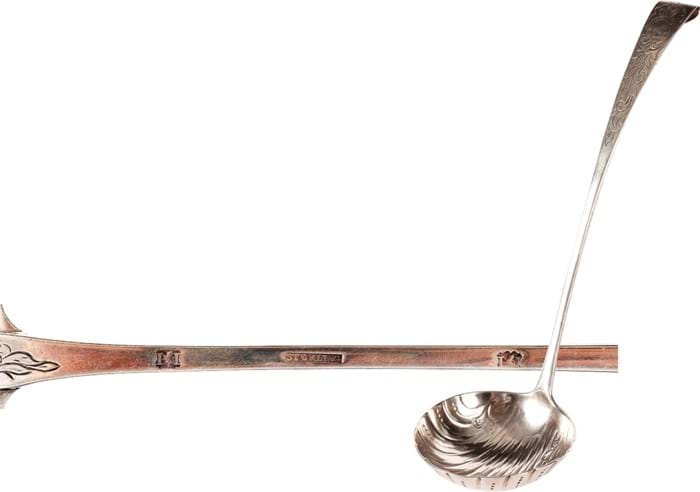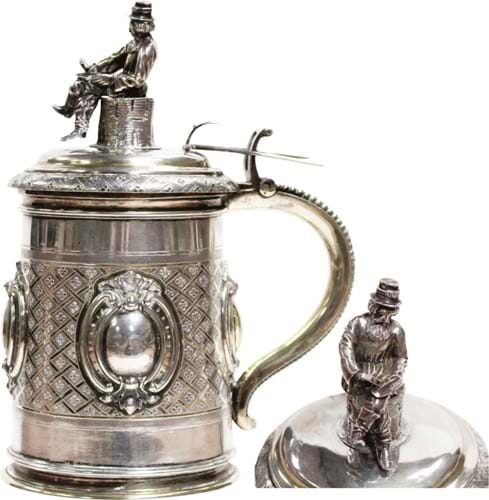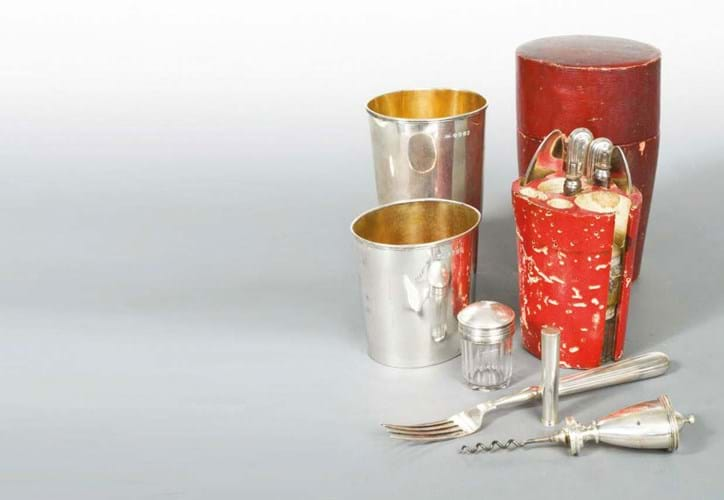Moving from Aberdeen, where he had been an incorporated hammerman since 1666, he settled in the royal burgh sometime in the last quarter of the 17th century. Like some other Scottish provincial makers, he and his son (William Scott the Younger) were itinerants, conducting business in Aberdeen, Banff and in Elgin where the Scott mark was registered in 1701.
Any silver hollowware marked in Banff is a rarity (only the work of John Keith – active c.1794-1824 – appears on the market with sporadic regularity). Pieces made in this much earlier period are like the proverbial hen’s teeth.
But one – a handsome 4oz tumbler cup c.1680 – did turn up for sale at Cheffins (25/12% buyer’s premium) in Cambridge on August 1. It was in remarkable condition for its age (just two minor cracks to the rim counted against it) and had not been on the market since it was purchased by an ancestor of the vendor c.1940.
Alongside the marks VS and ABC (Scott used the first three letters of the alphabet as his Banff town mark) were the pricked letter M and the initials AK and BB.
Remarkably, genealogical research suggests that between 1650-1750 only one marriage took place in the county of Aberdeenshire between a couple with these initials: the union of one Alexander Ker and Bessie Burne on September 17, 1668. There is more than a possibility that this cup was connected in some way – perhaps commissioned to mark a significant anniversary.
What an item from the pinnacle of Scottish silver collecting was worth in the current market proved a matter of conjecture. A typical Banff silver teaspoon, once £300-350, is currently far more accessible at £60-70. But the guide of £5000- 8000 for this cup was an appealing one. Ultimately it topped the sale, going to the trade at £11,000.
Despite various acts of Parliament, many silversmiths from the burghs of Scotland enjoyed sufficient independence from the assay office to use local marks.
They did this to avoid the perils of travel and (after 1784) to escape paying duty in a region where a heathy distain for the Hanoverians persisted well after 1745 and all that. Currently some 30 different centres of production are recorded from Arbroath to Wick.
Glasgow hollowware
Lyon & Turnbull’s (25% buyer’s premium) sale of Scottish Silver & Applied Arts on August 14 also included good examples of 18th century Glasgow hollowware – made at a time when the city was relatively small and supported just a handful of silversmiths.
A bullet-form teapot and a baluster-form coffee pot were both marked for James Glen who was admitted to the Incorporation of Hammermen in 1743. The 23oz teapot with a flat chased border of acanthus leaves and foliage, ball finial, leaf-clasped spout and C-scroll handle sold for £2200. The coffee pot with chased shell and scroll borders took £3800.
Milne and Campbell were from the next generation of Glasgow smiths. A triangular-form kettle stand with gadrooned border, cast floral details and three hoof feet took £1600.
A trio of cowrie shell snuff boxes by provincial makers provided instructive prices. The example by David Lizat of Banff sold at £450 with another marked for William James of Aberdeen selling at £340. However, that struck with the marks for John Anderson of Inverness took £850.
Peterhead produce
For collectors seeking silver made in Peterhead, one of the rarest Scottish silversmithing centres, a spoon or perhaps a wine label is the only realistic expectation. Here a fiddle pattern toddy ladle marked WS, PHd for William Smith of Peterhead took £600.
Estimated at £200-300, a humble George II Hanoverian pattern tablespoon sold for £4600. The key to its appeal was not the rare marks of an obscure Highlands goldsmith but the crest to the reverse for John Hope, 2nd Earl of Hopetoun (1704-81).
For two generations the Hopetoun family, led by Charles and John Hope, 1st and 2nd Earls, were perhaps the most important commissioners of silver in Scotland. However, flatware bearing the crest of a broken terrestrial globe beneath a cloud-issuing rainbow with the motto At Spes Infracta (Yet my hope is unbroken) is surprisingly scarce.
It appears the family cutlery (this 2oz spoon with marks for Kerr & Dempster of Edinburgh, 1753) was regularly recycled into the larger, more impressive wares which perversely survive in greater numbers. Two collectors provided the business end of a titanic bidding contest.
Also assayed in Edinburgh (by William Cunningham, 1840) was a marrow scoop cast with the crest and motto of The Marrowbone Club and engraved for a former member, Thomas Brown.
The club met at Fleshmarket Close from the 1830s with each member (typically Lords of Session, the most senior body of Scottish judges) owning one of these heavy gauge 3.2oz scoops to enjoy their marrow. It went at the top end of a £400-600 estimate.
Another item appealing to a very specific collecting sphere was a solid silver flatiron made in Edinburgh 1927 with 22oz of sterling as a presentation piece.
An inscription explained it had been a gift to the Right Hon Sir Alexander Stevenson, Lord Provost of Edinburgh, by the Craigmillar Steam Laundry Company. It sold for £360 – but try and find another one.
Ladle scoops up £3000 price
This c.1760 Irish provincial hook end silver ladle sold for £3000 at Chorley’s (20% buyer’s premium) in Priknash Abbey, Gloucestershire, on July 23 carries the marks of Joseph Johns of Limerick. He is often deemed Limerick’s most accomplished, prolific and most successful silversmith and he rose to the position of mayor in 1773 as well as holding other official positions.
The hook end and large shell bowl are typical of Limerick ladles at this time while the crest appears to be the arms of the County Limerick Barons Carbery (Evans-Freke), a title that was created in 1715.
‘Peoples of Russia’ sit well in silver form
The ‘Peoples of Russia’ series of porcelain figures, which presented a romantic image of old Russia and the different ethnic groups who lived in its empire in the wake of the Patriotic War of 1812, are regular visitors to the saleroom. It is more unusual to see similar sentiments evoked in silver.
This 36oz silver-gilt tankard was marked for assay master Eduard Fyodorovich Brandenburg, St Petersburg assay master from 1850-66. The finial to the cover is a seated Russian artisan – perhaps even a silversmith hammering a sheet of metal across his lap. At the Adam Partridge (20% buyer’s premium) saleroom in Liverpool on August 7 it took a multi-estimate £5000.
For collectors with grater expectations
This George III silver travelling or campaign canteen (London 1802) was probably made by William Parker but retailed by William Eley & William Fearn.
As well as a pair of beakers, two glass condiment jars with silver gilt pierced grills and a fork, spoon, teaspoon and two knives with steel blades, a combined nutmeg grater and corkscrew also features. The latter typically broadens the market for these pieces to specialist collectors: most nutmeg grater collectors will hope to own at least one of them.
Housed in a typical wood and leather carrying case, it took £3800 (estimate £600-800) at Cheffins in Cambridge.




